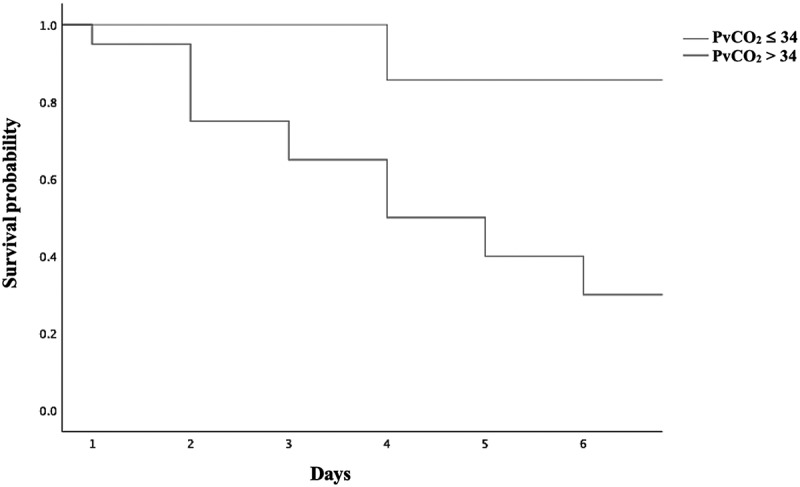Usefulness of peripheral venous blood gas analyses in cats with arterial thromboembolism.
IF 3.2
Q1 VETERINARY SCIENCES
International Journal of Veterinary Science and Medicine
Pub Date : 2021-10-26
eCollection Date: 2021-01-01
DOI:10.1080/23144599.2021.1982335
引用次数: 5
Abstract
ABSTRACT Feline arterial thromboembolism (ATE) is a condition with a high mortality rate. Acid-base abnormalities may be beneficial to the prognosis of cats with ATE. Venous blood gas and electrolytes data on the first day of ATE presentation of 47 cats with ATE were retrospectively reviewed and analysed. The Cox and logistic regression were analysed to evaluate the relationship between acid-base parameters and death. The most common venous acid-base disorder was simple metabolic acidosis. Age, body weight, and partial venous pressure of carbon dioxide (PvCO2) differed between the dead and alive groups within 7 days of the onset of ATE presentation (p < 0.05). Cox-regression showed that increasing age (HR=1.175 [95% CI: 1.027-1.343], p = 0.019), increasing PvCO2 (HR=1.066 [95% CI: 1.010-1.125], p = 0.021) and PvCO2 more than 34 mmHg (HR=7.878 [95% CI: 1.036- 59.915], p = 0.046) were associated with increased hazard of death. Multivariable logistic regression showed that age > 5 years (OR=9.030, 95% CI: 1.258- 64.823; p=0.029), and PvCO2 > 34 mmHg (OR=21.764, 95% CI: 1.747-271.141; p=0.017) were associated with an increased risk of death, while concomitant administration of enoxaparin with clopidogrel (OR=0.111, 95% CI: 0.015-0.795; p=0.029) were associated with a decreased risk of death within 7 days of the onset of ATE presentation. This study demonstrated the power of venous blood gas analysis which may be used as prognostic indicators for cats with ATE.


外周静脉血气分析在猫动脉血栓栓塞中的应用。
猫动脉血栓栓塞(ATE)是一种死亡率很高的疾病。酸碱异常可能有利于ATE猫的预后。回顾性回顾和分析47只ATE猫在ATE出现第一天的静脉血气和电解质数据。采用Cox和logistic回归分析评价酸碱参数与死亡的关系。最常见的静脉酸碱失调是单纯代谢性酸中毒。死亡组和活组在ATE出现后7天内的年龄、体重和二氧化碳分静脉压(PvCO2)差异有统计学意义(p < 0.05)。cox回归分析显示,年龄增加(HR=1.175 [95% CI: 1.027 ~ 1.343], p = 0.019)、PvCO2增加(HR=1.066 [95% CI: 1.010 ~ 1.125], p = 0.021)、PvCO2大于34 mmHg (HR=7.878 [95% CI: 1.036 ~ 59.915], p = 0.046)与死亡风险增加相关。多变量logistic回归显示年龄> 5岁(OR=9.030, 95% CI: 1.258 ~ 64.823;p=0.029), PvCO2 > 34 mmHg (OR=21.764, 95% CI: 1.747-271.141;p=0.017)与死亡风险增加相关,而依诺肝素与氯吡格雷合用(OR=0.111, 95% CI: 0.015-0.795;p=0.029)与ATE发病后7天内死亡风险降低相关。本研究证明了静脉血气分析的力量,它可以作为ATE猫的预后指标。
本文章由计算机程序翻译,如有差异,请以英文原文为准。
求助全文
约1分钟内获得全文
求助全文
来源期刊

International Journal of Veterinary Science and Medicine
VETERINARY SCIENCES-
CiteScore
4.80
自引率
0.00%
发文量
12
审稿时长
24 weeks
 求助内容:
求助内容: 应助结果提醒方式:
应助结果提醒方式:


